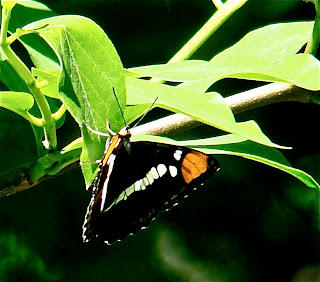

 The last Sonoma Valley park on the closure list has been saved after the county’s Board of Supervisors unani-mously approved a contract to allow Sonoma County Regional Parks to manage Annadel State Park, begin-ning July 1. Sonoma News reports that funding is in place to manage the park for one year!
The last Sonoma Valley park on the closure list has been saved after the county’s Board of Supervisors unani-mously approved a contract to allow Sonoma County Regional Parks to manage Annadel State Park, begin-ning July 1. Sonoma News reports that funding is in place to manage the park for one year!
Thirty-five miles of hiking trails plus good black bass and bluegill fishing are the high-lights of Annadel. Hiking and biking to Lake Ilsanjo, is a popular day hike and this was my plan for the day.
Unfortunately I had to limit my hike to about three miles. Day use hours for many of the parks I've visited are "sunrise to sunset." Annadel, however, was locking the gate at 4:30 pm, making a 2:00pm start a little tight for the round-trip hike, especially since wildlife kept distracting me and my camera.
Oak forests, lakes, grass-lands and meadows are the main geographic features of Annadel, with 5,000 plus acres offering over forty miles of hiker/biker trails. It boasts one of Northern California’s most undisturbed oak woodlands, with abundant bird and animal life, flowing streams, and a spectrum of wildflowers in late spring. With its location right in town, it offers woodsy outdoor opportunities for Santa Rosa area residents with an easy few minutes drive.

 The Pomo and Wappo Indians were the first people attracted to the area, gather-ing the shiny black obsidian rock to carve knife blades and arrowheads.
The Pomo and Wappo Indians were the first people attracted to the area, gather-ing the shiny black obsidian rock to carve knife blades and arrowheads.
Basalt was quarried here at the turn of the century. It was used to rebuild San Francisco after the 1906 earthquake.
Lake Ilsanjo - my hiking destination - was actually built by two former landowners in 1956 - Ilsa and Joe Coney - for whom the lake is named. In 1971, Annadel became a state park.
For the first mile or so of my hike, I was treated to silence and aloneness, an aspect of hiking I am coming to treasure with increasing enthusiasm. I was rewarded by an abundance of visitors - mostly small herds of deer and several flocks of turkeys - who seemed to understand that my still and quiet stance posed no threat to them. They actually seemed to be posing for me.
 A Junko darted back and forth across my path. A polite bicyclist - seeing that I was trying to get a photo of the bird - stopped a ways back and held still. I didn't even notice him until I came up from my camera. I thanked him for his courtesy of course.
A Junko darted back and forth across my path. A polite bicyclist - seeing that I was trying to get a photo of the bird - stopped a ways back and held still. I didn't even notice him until I came up from my camera. I thanked him for his courtesy of course.
It takes about $350,000 to run Annadel for a year. To keep it open for this first, trial-basis year, the state has agreed to staff a fulltime ranger for an in-kind contribution of $100,000. Another $100,000 came from Santa Rosa based philanthropist Henry Trione.

 Two major local races raise additional capital. The Annadel Half Marathon, raised $40,000 for the park this year, and is set to come back in 2013. The Santa Rosa based company Bike Monkey will be donating the proceeds of its cross-country bike race through Annadel, set for Aug. 18, which last year netted $27,000 for the park.
Two major local races raise additional capital. The Annadel Half Marathon, raised $40,000 for the park this year, and is set to come back in 2013. The Santa Rosa based company Bike Monkey will be donating the proceeds of its cross-country bike race through Annadel, set for Aug. 18, which last year netted $27,000 for the park.
Hm. I recently acquired a bicycle. Maybe by the 2013 event I'll be ready to ride!
Friends of Annadel continues to be a focal point for com-munity conversation, and a way for the entire Annadel community to get involved with and support the park.
Suddenly the deer seemed jumpy and began heading deeper into the woods. The turkeys began meandering away. Then I heard it too.

 No, not a mountain lion. Rather, it was the sound of loud, adolescent, female voices discussing hair, jewelry and make-up. Within a few seconds, two teenage girls on their bicycles zoomed by. Ah well. I'd had my turn in the forest and now it was theirs.
No, not a mountain lion. Rather, it was the sound of loud, adolescent, female voices discussing hair, jewelry and make-up. Within a few seconds, two teenage girls on their bicycles zoomed by. Ah well. I'd had my turn in the forest and now it was theirs.
The wildlife disappeared. I wasn't going to make it all the way to Lake Ilsanjo. I decided to head back to the car. There was enough time left for me to enjoy my return trip without having to constantly check the clock. I made it through the park gate with twenty minutes to spare.
I hope to see you at the State Parks.
Lucy
This blog is dedicated to the memory of my Father, who loved reading maps, exploring alternate routes, and taking the road less traveled.
Alvin David Dick, April 28, 1926 - May 20, 2012
























































